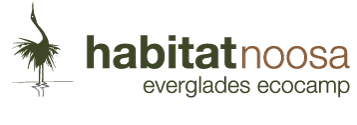Eco Journey
What is the Habitat Noosa journey? This region bears a very rich and interesting history, leading up to the current day. In fact, many of you may be familiar with the location having visited as a child or adult what was known as the Elanda Point Education Centre. You may ask how does this relate to our Eco Journey, well read on…………

Habitat Noosa Eveglades EcoCamp is located in the Great Sandy National Park, with an expanse of almost 70,000 hectares. Perched on the edge of stunning Lake Cootharaba which is the largest tidal lake in Queensland.
Our 65 acre Eco Tourism precinct was years in the planning to ensure it offered domestic and international tourists a uniquely Australian wilderness experience with access to some of Queensland’s most magnificent landscapes and waterways. To better explain our Eco Journey we will start at the beginning…..
The Cooloola region was originally named in the language of the Gubbi Gubbi traditional owners, meaning “the sound the wind makes as it whispers through the branches of the trees”. The arrival of Europeans quickly led to mass displacement for the Gubbi Gubbi and the land was given over to mining, logging and agriculture.
1869-1892
Mill Point, the initial settlement site was developed into a thriving sawmill by Luya & Co timber mill. The 1867 gold rush in Gympie created massive demand for timber in the region for the mines and homes for all the workers. The company had invested approximately 2,000 pounds in the sawmill, which by the late 1880’s employed between 100-150 men. The sawmill covered approximately 25 hectares and created the need for carpenters, blacksmiths, stables, a hotel, post office and homes for the families. A small village was built at Boreen Point in close proximity to the sawmill.
The timber was collected in the surrounding scrubs and transported to the sawmill via bullock teams and later the tramway, ultimately to be shipped to Brisbane for sale. The sawmill officially closed in 1892 due to dwindling timber resources.


1910-1974
Dairy farmers worked on the land until Elanda Point was gazetted as a national park. The Australian Government purchased 1,000 acres in Queensland – including Elanda Point and Mill Point. This area became known as the Cooloola National Park.
1975
Brian Mays was successful in securing the initial 10-year lease at Elanda Point, issued by the Commonwealth Government of Australia. This being the start of the Elanda Point Education Centre. Basic premises were constructed to make way for on-site facilities.
1981
Australia’s Prime Minister approves the Commonwealth Government sale of Elanda Plains property to the Queensland Government. The region eventually became known as the Great Sandy National Park Reserve.
1983-1986
Queensland National Parks and Wildlife take possession of the title Elanda Point land and issue Brian with two long term 50 year leases – operating as the Elanda Point Education Centre. The campgrounds were a popular spot for Scout and Girl Guide groups alike.
2006
The University of Queensland undertake an archaeological dig, north of Elanda Point at Mill Point. What they uncovered was the remnants of the private timber town inhabited between 1869 – 1892. This historical landmark is documented.


2016
The current lease owner Wade Batty is successful in the contract of sale, securing the leases. This was the start of our own Eco Journey. The future of the region was looking bright with an emphasis on conservation and protection of the land. Plans are put in place to upgrade the facilities that are all designed to be easily removed at any time with minimal impact on the environment. Conservation was the forefront of every building decision.
2018
In July 2018 renovation & new works are completed and Habitat Noosa officially opens to the public.
Present day
Habitat Noosa is operating successfully as an eco-tourism business. Paying respect to nature and the land. Implementing measures such as bio-degradable packaging and utensils throughout the onsite bistro. Installing recycled and sustainable materials where possible. Utilising solar power for all powered sites with hundreds of solar panels that generate 40 kilowatts of power. Naturally sourcing and treating over 1600 kilo litres of water. Providing the 65 acres of native trees with regular watering form the same water we use onsite. The impacts from Climate Change and Global Warming present a threat to Noosa Everglades, therefore making our EcoCamp 80% sustainable with power and 100% sustainable with water ensures we are actively working to reduce the carbon emissions created by the business.
Habitat Noosa are proud to be operating as an eco-tourism business and our Eco Journey has taught us all so much about the region and the importance of sustaining this natural environment. We feel it is important to share the history and significance of the environment through our products. This is the heart of what we believe in and what we will always emphasise.
We offer our guests an – Accessible wilderness experience!

